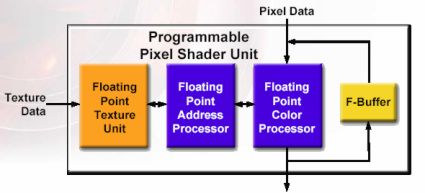Strike Force: The new ATI Radeon 9800, 9600 and 9200 Series
Smart Shader 2.1
The most interesting change from SmartShader 2.0 and 2.1 is the addition of the so-called "F-Buffer", which stands for "Fragment-Stream FIFO buffer". With this new technique, it's theoretically possible to run shader code of infinite length without having to resort to performance-reducing multi-pass operations - note the word "theoretically." In practice, the VPU's performance will quickly limit the length of code that can realistically be run.
The advantage is obvious, though. If the length of a certain piece of shader code exceeds the maximum length specified in DirectX 9, the effect has to be broken down into several steps or passes - if possible. The trouble is that each pass will again require bandwidth-intensive memory accesses (vertex processing, backface culling, triangle setup, texture sampling, pixel shading, stencil testing, Z testing, anti-aliasing). The F-Buffer solves this problem. The concept of the F-Buffer is built on the ideas of William R. Mark and Kekoa Proudfoot of Stanford University .
In practice, the F-Buffer probably won't play much of a role in the foreseeable future, since it will likely be a while yet before pixel shader 2.0 code makes an appearance in games, let alone exceeds the maximum code length. Current chips simply don't offer sufficient performance. By the same token, the extended programmability of the GeForceFX is only a theoretical feature at this point.
SmoothVision 2.1
Compared to SmoothVision 2.0, version 2.1 sports an optimized memory controller. The benefit of this improvement should be better performance in 4x and 6x FSAA in resolutions of 1024x768 and above. ATi is also advertising its color compression feature for the first time. Its compression factor of 6:1 is also higher than that of the GeForceFX (4:1).
HyperZ III+
The optimizations in HyperZ III+ mostly affect the improved Z-Cache, which is now more flexible and was optimized for stencil-buffer data. One application of stencil calculations will be to create realistic shadows in future games. The Doom 3 Engine will make heavy use of this feature, for example. But even current games, like Ubisoft's Splinter Cell, make use of stencil data. ATi is reacting to this with its improved Z-cache.
Get Tom's Hardware's best news and in-depth reviews, straight to your inbox.
The planned launch and introduction into the market is March 2003. Here's a list of the different versions of the card:
- Radeon 9800 PRO 256 MB DDR II (?/?); available: April 2003; price: $499
- Radeon 9800 PRO 128 MB DDR (380/680); available: March 2003; price: $399
- Radeon 9800 128 MB DDR; available: March 2003; price: $349
And, in summary, a short overview of the R350's features:
- DirectX 9
- 8 pixel pipelines (8x1 design)
- 4 vertex shader units
- 0.15 micron manufacturing process
- 256-bit DDR memory (DDR-II ready)
- Up to 256 MB memory
- SmartShader 2.1 (F-Buffer)
- SmoothVision 2.1 (optimized FSAA, AA & memory controller, 6:1 color compression)
- HyperZ III+ (24:1 Z-compression, optimized Z-cache)
